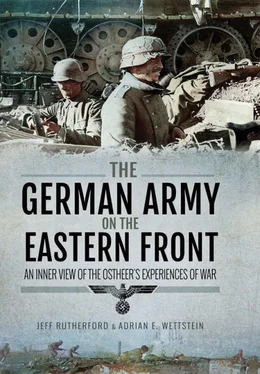The next source presents a different type of learning, one that focuses on weapons. One year after the invasion, a special mission of officers and officials of the First Department (Munitions and Ballistic) of the Army Ordnance Office’s Group for Development and Testing was sent to Army Group North on a fact-finding mission. The small staff toured Army Group North’s area from 10 June to 13 July 1942, visiting staff officers from all levels of the hierarchy, from the Army Group down to battalions, as well as units in the field of all kinds, including the often-forgotten army coastal artillery battalions. Rear-area installations, such as collection points for captured material and field workshops, were also visited. Additionally, the staff talked with individual soldiers, including specialists in anti-tank warfare, and interrogated captured Soviet officers. Their findings were summarized in the following report: [7]
The aim of the mission was to ascertain if the troops possessed sufficient weapons, equipment and munitions for the actual demands, as well as forwarding on the wishes, demands and suggestions of the troops in the quickest way to the department. […]
The troops clearly recognized that the bureau had recently developed many good weapons; on the other hand, flaws and complaints were expressed openly and without reserve. Frequently voiced was: why doesn’t the bureau give us this or that? Why do we get so little munitions? Why don’t we get these weapons?
That the allocation of weapons and equipment is not the business of the bureau was often not known; many incorrect suspicions of the bureau could be dismissed.
Further, it was possible to establish a vibrant contact between the troops and the bureau, a direct connection which will persist beyond the posting. This appears to be even more necessary as the monthly condition reports of the divisions can contain only particular details and are cut considerably by the corps and armies.
Furthermore, it is not only practical, but urgently necessary, that officers of the bureau who have no idea about the war in the East personally receive an opportunity to see the terrain in which the troops fight. Especially the bog forest that predominates in large sections of Army Group North and which demands the most of men and material, is at its foremost unique in Europe.
Between Lakes Ilmen and Ladoga, countless battalions lay day and night in the swamp. The enemy shells with artillery and heavy mortars, constantly causing casualties. At the same time, our own field of fire is only 30 to 50m at the most. Connection from combat position to combat position consists only of duck boards, that sink again and again and that must be continually worked on.
Difficulties with food do not exist in the summer, water for washing is extremely scarce. The mosquito plague is considerable, especially at night. Nothing like relief is known, given that neither the divisions nor the army command possess even a single reserve company. Everything is permanently in the frontline.
The supply routes of many infantry regiments, the only connection between the main combat line and hinterland, were muddy to such an extent even in the month of June, that light, only partially loaded field wagons had to be drawn by 6 strong horses, who, literally in the mud up to the belly, could themselves only slowly work forward.
What the infantry, the forward parts of the artillery and anti-tank units suffer daily and hourly in that terrain – even under positional warfare conditions – cannot be overestimated.
The majority of the agencies had a great interest in weapons and ammunition; likewise, they were willing to report orally and in writing. During the mission, 3 preliminary reports with a rash of notes by the troops were submitted; meanwhile they have been sent to the responsible sections.
Attached to the final report are 36 troop reports:
SS Infantry Regiment 9, Infantry Regiments 151, 162, 176, 380, 390, 489, cycle battalion 402: Answers to the questionnaire: ‘Infantry’. [8]
Artillery Commander 123, Artillery Regiments 110, 193, 215 (2x), 269: Suggestions for improvement, artillery pieces, munitions, optical equipment.
Infantry Regiment 490, 1st Infantry Division, 61st Infantry Division, Group Debes: Responses to questions of Fourth Department. [9]
Engineer battalions 1, 161, 193, 269: Answers to questions of Fifth Department. [10]
Anti-tank Battalion 193: modification suggestions.
Anti-tank Battalion 563: Experiences with the 5cm ATG 38 against T 34
Anti-tank Battalion 563, 269th Infantry Division: Experiences with the Stielgranate (stick shell) 41. [11]
Artillery Regiment 269: Experiences with 10cm shell 39 (red) hollow-charge.
12th Panzer Division: Experiences with self-propelled 7.62cm ATG.
Panzer Engineer Battalion 32: Experiences with heavy rocket launcher 40.
Infantry Regiment 24: Experiences with heavy Russian mortar.
III./SS Regiment 9: Safety of MP 38 and 40.
1st Infantry Division: Equipment, spare parts, […]
Ist Army Corps: Munitions, adhesive [hollow] charge, vehicles, sleds.
Divisional Supply Commander 21: Sleds […]
The report mentions an often forgotten fact; namely the relative ignorance of German central institutions about the demands at the sharp end of the Eastern front. Of course, over the years as personnel shifted from the central institutions to the Eastern front or vice-versa, this knowledge increased, but such unfamiliarity led to the development of weapons not entirely useful in Russian conditions. Some examples include the overlapping road wheels used by the Tiger and Panther tanks, or the heavy German ATG.
In summary, it is to say: the problem is anti-tank defence. Adhesive charges, Stielgranate and Russian ATG were thankfully welcomed everywhere; plenty of special requests and suggestions for improvement were reported and forwarded to the bureau in the preliminary reports.
Generalfeldmarschall von Küchler demanded, in reference to the Stielgranate 41 , that a gun had to destroy more than 2 tanks, since they always appear in a wedge formation in threes, often in larger quantities. Many ATGs and light field howitzers have been overrun by tanks because they were attacked in too great numbers. The tank shock, however, has been overcome, especially after the introduction of the adhesive charge.
The Generalfeldmarschall then dealt with the wearing out of artillery barrels. He spoke about the scattering of shells up to 500m when firing on a medium distance, so that shelling could not happen as close to the infantry as necessary. […]
Generalmajor Hasse, Chief of Staff of Army Group North, himself commented on the anti-tank defence as follows: Stielgranate good, but too delicate, range too small. The 3.7cm and also the 5cm ATG were usually powerless against the T-34, which was the predominant tank in the north. During the development of ATGs, one must strengthen their penetrative power as the armour of Russian tanks has become increasingly stronger.
He said that at the moment, anti-tank defence had reached its lowest point. This was countered by the development of the heavy ATG, which had been completed long ago. However, the new weapons are not yet available in such large quantities to equip all divisions with them. But the situation is improving from month to month. Meanwhile, General Hasse will have changed his negative point of view after the enormous successes of our anti-tank defence in the Volkhov cauldron and in the Volkhov bridgehead Kirishi.
The rifle (anti) tank grenade, while joyfully welcomed by the troops, had too small an effect. The destruction of tanks by hand is only a stopgap measure that one cannot afford in the long run; this objection must be agreed to.
Читать дальше






![John Stieber - Against the Odds - Survival on the Russian Front 1944-1945 [2nd Edition]](/books/405234/john-stieber-against-the-odds-survival-on-the-russian-front-1944-1945-2nd-edition-thumb.webp)





